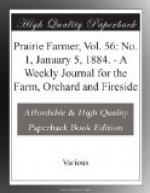If “I will help you”
were the rule.
How changed beyond
all measure
Life would become! Each
heavy load
Would be a golden
treasure;
Pain and vexation be forgot;
Hope would prevail in every
lot,
And life be only
pleasure.
—Wolstan Dixey.
A CHAT ABOUT THE FASHIONS.
Although the lady readers of THE PRAIRIE FARMER have probably by this time made up the heavier part of their winter wardrobe, still a few suggestions may not be out of place, for the “fashions” is a subject of which we seldom tire.
In discussing the subject of silk and silk-culture at the late Woman’s Congress, Mrs Julia Ward Howe said that “although silk is said to be depreciating in value, and is not quite as popular as formerly, yet we must confess it lies very near the feminine heart,” at which statement an audible smile passed over the audience, as each one acknowledged to herself its truth.
We are glad to see that wrappers are becoming quite “the thing” for afternoon home wear, and a lady now need not feel at all out of place receiving her callers in a pretty, gracefully made wrapper. The Watteau wrapper is made of either silk or brocaded woolen goods, conveniently short, the back cut square at the neck, and folded in a handsome Watteau plait at the center, with a full ruche effect. A yolk portion of silk fills in the open neck and is sewed flatly underneath to the back. The side seams are curved so that a clinging effect is produced at the sides. Jabbots of lace extending down the front, and a prettily bowed ribbon at the right shoulder, with a standing collar at the neck, and a linen choker collar give the finishing touches to the toilette.
Velvets and velveteens seem to be taking the place of silk, and are really quite as cheap. In fact, velveteens are cheaper, as they are so much wider. A suit of velveteen is fashionable for any occasion—for receptions, church or street costume. The redingote or polonaise is very stylish and pretty, especially for a tall, rather slight person. For a young miss the close-fitting frock coat, with pointed vest effectively disclosed between the cut-away edges of the coat fronts, is much worn. The latter curve away from the shoulders and are nicely rounded off at their lower front corners. An underarm dart gives a smooth adjustment over each hip, and in these darts are inserted the back edges of the vest. Buttons and buttonholes close the vest, but the coat fronts do not meet at all. The coat and long-pointed overskirt can be made of any heavy material, but the vest should be of silk; a deep box-plait on the bottom of the underskirt made of silk to match the vest will make the suit very stylish and pretty.




